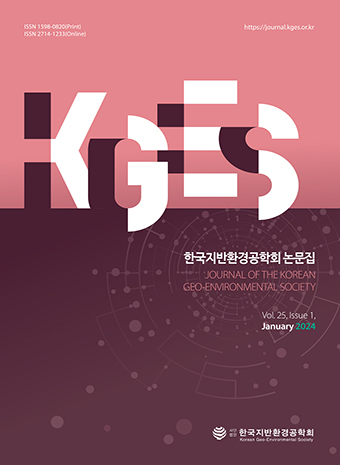Akagawa, S. (1988), Experimental study of frozen fringe characteristics, Cold Regions Science and Technology, Vol. 15, pp. 209~223.
10.1016/0165-232X(88)90068-7Azmatch, T. F., Sego, D. C., Arenson, L. U. and Biggar, K. W. (2011), Tensile strength and stress-strain behaviour of Devon silt under frozen fringe conditions, Cold Regions Science and Technology, Vol. 68, pp. 85~90.
10.1016/j.coldregions.2011.05.002Bronfenbrener, L. and Bronfenbrener, R. (2010), Modeling frost heave in freezing soil, Cold Regions Science and Technology, Vol. 61, No. 1, pp. 43~64.
10.1016/j.coldregions.2009.12.007Casagrande, A. (1931), Discussion of frost heaving, Highway Research Board, Proceedings, Vol. 11, pp. 163~172.
Chamberlain, E. J. (1981), Frost susceptibility of soil, review of index tests, Cold Regions Research and Engineering Lab Hanover NH, Hanover
Chen, S. X. (2008), Thermal conductivity of sands, Heat Mass Transfer, Vol. 44, pp. 1241~1246.
10.1007/s00231-007-0357-1Jin, H., Ryu, B.H., Kang, J. and Lee, J. (2021), Engineering approach to determination of the segregation potential by the upward-step-freezing testing method, Cold Regions Science and Technology, 191, 103361-1-15.
10.1016/j.coldregions.2021.103361Konrad, J.M. (1994), Sixteenth canadian geotechincal colloquium: Frost heave in soils: Concepts and engineering, Canadian Geotechnical Journal, 31, 223~245.
10.1139/t94-028Michalowski, R. L. (1993), A constitutive model of saturated soils for frost heave simulations, Cold Regions Science and Technology, Vol. 22, No. 1., pp. 47~63.
10.1016/0165-232X(93)90045-AMichalowski, R. L. and Zhu, M. (2006), Frost heave modelling using porosity rate function, International Journal for Numerical and Analytical Methods in Geomechanics, Vol. 30, pp. 703~722.
10.1002/nag.497Lee, J., Gong, Z., Jin, H. and Ryu, B. H. (2023), Numerical model with segregation potential on frost heave and reliability assessment for silty soils, Journal of the Korean Geo-Environmental Society, Vol. 24, No. 9, pp. 41~46.
O'Nelli, K. (1983), The physics of mathematical frost heave models: a review, Cold Regions Science and Technology, Vol. 6, No. 3, pp. 275~291.
10.1016/0165-232X(83)90048-4Park, D. -S., Shin, M. -B. and Seo, Y. -K (2021), Development of numerical analysis model for the calculation of thermal conductivity of thermo-syphon, Journal of the Korean Geotechnical Society, Vol. 37, No. 1, pp. 5~15 (In Korean).
Thomas, H. R., Cleall P., Li, Y.-C., Harris, C. and Kern-luetschg, M. (2009), Modelling of cryogenic processes in permafrost and seasonally frozen soils, Geotechnique, Vol. 59, No. 3, pp. 173~184.
10.1680/geot.2009.59.3.173Tice, A. R., Black, P. B. and Berg, R. L. (1989), Unfrozen water contents of undisturbed and remolded alaskan silt, Cold Regions Science and Technology, Vol. 17, No. 2, pp. 103~111.
10.1016/S0165-232X(89)80001-1Williams, P. J. and Smith, M. W. (1989), The frozen earth: fundamentals of geocryology, Cambridge University Press, Cambridge, pp. 1~306.
10.1017/CBO9780511564437Zhang, Y. (2014), Thermal-hydro-mechanical model for freezing and thawing of soils, the University of Michigan, Michigan, pp. 1~217.
- Publisher :Korean Geo-Environmental Society
- Publisher(Ko) :한국지반환경공학회
- Journal Title :Journal of the Korean Geo-Environmental Society
- Journal Title(Ko) :한국지반환경공학회 논문집
- Volume : 25
- No :7
- Pages :29-34
- Received Date : 2024-06-11
- Revised Date : 2024-06-12
- Accepted Date : 2024-06-24
- DOI :https://doi.org/10.14481/jkges.2024.25.7.29




 Journal of the Korean Geo-Environmental Society
Journal of the Korean Geo-Environmental Society





